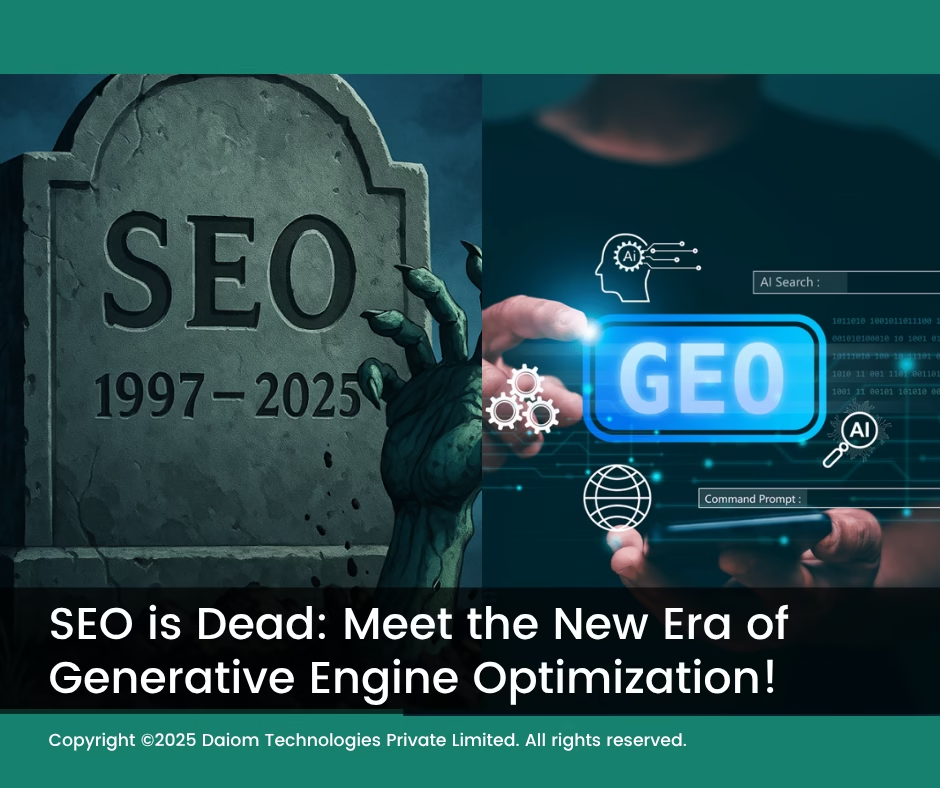While we have been focusing on writing blogs and SEO, we noticed that around 2-3% of our traffic is now coming from Perplexity and ChatGPT.
This is because user behaviour is changing.
People are no longer typing short keywords like “best laptops 2024” in search. They are asking full questions like “Which is the best laptop for college students under ₹50,000?” on these AI platforms.
And to appear in these answers, your content needs to be optimized for what is now called Generative Engine Optimization (GEO).
But that’s not all.
There’s also Answer Engine Optimization (AEO)—which is about answering direct questions that people ask on Google or voice search, where the focus is on giving direct, helpful answers instead of just stuffing keywords.
Here’s the difference:

- GEO helps you show up in answers generated by AI tools like ChatGPT or Perplexity. These tools pick information from many sites and build their own response. So your content should be well-rounded, factual, and trusted enough to be part of that answer.
- AEO is for search engines like Google, where your page shows up as a direct answer to a question typed by the user.
What’s interesting is that Google is also getting ready to launch its own page—just like Perplexity and ChatGPT—where users will get direct AI-generated answers on top of search results.
This is called AI Overviews.
In fact, Google’s AI Overviews already reached 1 billion users per month in 2024.
Read more – How Is Search Changing With AI?
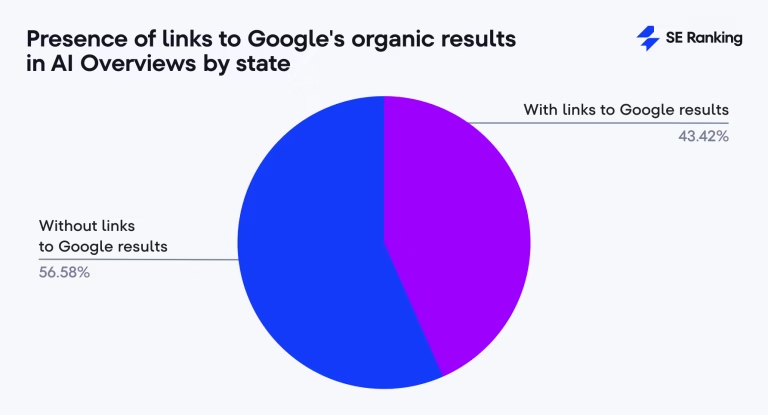
It may not have fully rolled out in India yet, but when it does, it’s going to change how people search and how brands get discovered.
Because users might not even scroll down to the usual website links—they’ll get their answer right there from Google’s AI. So, brands will need to rethink how they show up in these AI answers too.
This blog will break down how brands should approach the new SEO to GEO shift.
“More natural answers, a human‑inspired sense of context… that’s the promise of the generative AI built into Google Search.”
Elizabeth Reid, Vice President of Google Search
Table of Contents
1. Are You Getting Traffic From Gen AI Search?
It’s an important thing to notice because the way people search is changing. Earlier, most people typed keywords on Google to find information. But now, many are asking full questions on tools like ChatGPT, Perplexity, or Bing.
These platforms not only give direct answers but also show website links—which means they can send traffic to your site. So, brands can no longer focus only on Google. They need to keep track of these AI search tools too.
But how to measure this?
You can start by checking your Google Analytics to see where your website traffic is coming from.
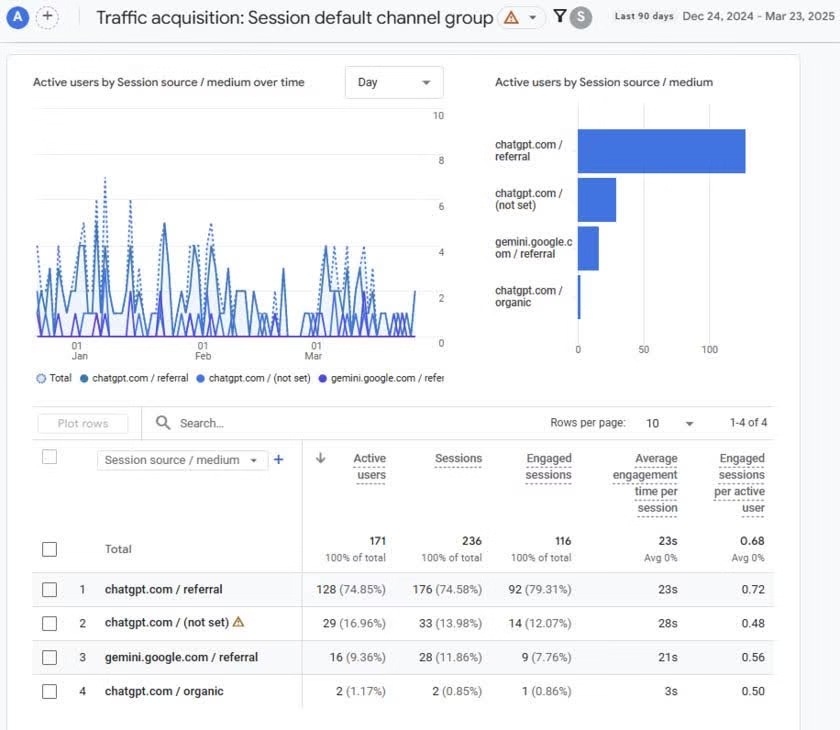
Right now, Google does not give a separate report for traffic from Gen AI search tools. But, you may notice that Bing’s traffic has gone up by 15% recently because of its AI features, while Google’s traffic has slightly dropped by 2.4%. This shows that more people are starting to use AI-powered search options like Bing with ChatGPT.

So even if Gen AI traffic is not clearly labeled yet, these small changes give clues that AI-powered search is starting to impact your site visitors. This trend will only get bigger with time.
2. Understanding GEO (Generative Engine Optimization)
GEO (Generative Engine Optimization) is the process of making your brand and content easy for AI tools like ChatGPT, Gemini, and Perplexity to understand, remember, and reference in their responses.

Earlier, SEO focused on ranking high on Google using backlinks, keywords, and proper site structure. But AI-driven search has changed this.
Now, GEO ensures that these AI models — which have already trained on over trillions of web pages — actually learn about your brand and store it in their memory. It matters because AI tools no longer just pick from Google’s top 10 results. Instead, they generate answers from what they’ve already ‘understood’ and ‘retained’ during training.
If your brand’s content isn’t part of this memory or knowledge base — you risk being completely invisible in this new AI-led search world.
2.1 The Key Differences Between SEO & GEO
SEO (Search Engine Optimization) and GEO (Generative Engine Optimization) may sound similar, but they serve very different purposes in today’s digital world.
SEO focuses on helping your website rank higher on search engines like Google to drive clicks and traffic.
GEO, however, is about making sure AI tools like ChatGPT, Gemini, and Perplexity understand, remember, and mention your brand when they generate direct answers for users — even when no search results are shown.

2.2 Where AI Tools Pull Their Answers From (And Why It Matters)?
Generative AI tools like ChatGPT, Perplexity, and Google’s AI Overviews don’t crawl the web the way traditional search engines do. Instead, they lean heavily on a few high-signal platforms to generate their responses.
Here’s what that looks like:
- ChatGPT leans heavily on Wikipedia and surprisingly, Reddit
- Google AI Overviews frequently cite Reddit, YouTube, and Quora
- Perplexity favors sources like LinkedIn, YouTube, and Reddit — especially for B2B content
These tools prioritize content that is clear, credible, and human — often skipping over traditional websites in favor of forums, explainer videos, and expert commentary.

What This Means for Brands:
It’s no longer just about your blog or website.
To show up in AI-generated answers, you need to show up on the platforms AI trusts most.
That means:
- Answering questions on Quora and Reddit
- Posting original insights on LinkedIn
- Creating useful explainer videos on YouTube
- And, if possible, earning a presence on Wikipedia
If you’re not visible on these platforms, your chances of getting cited in AI answers shrink—no matter how strong your SEO is.
3. Why Do Brands Need Both SEO and GEO?
Brands can no longer rely on just SEO or GEO alone — they need both to stay visible everywhere their audience is searching. SEO is still important because billions of people use Google and Bing every day to find products, services, and information. A strong SEO strategy ensures your website ranks well, drives traffic, and builds trust.
But AI tools like ChatGPT, Perplexity, and Gemini are changing this fast. People are now asking these tools questions directly and getting instant answers — without ever visiting a website. If brand content isn’t optimized for these AI models, brands might completely miss this new audience.
For example: You search for “Best running shoes for flat feet” on ChatGPT. The AI gives you 5 brand suggestions, but if your brand isn’t in the AI’s data, it won’t even get mentioned — no matter how good your SEO was.
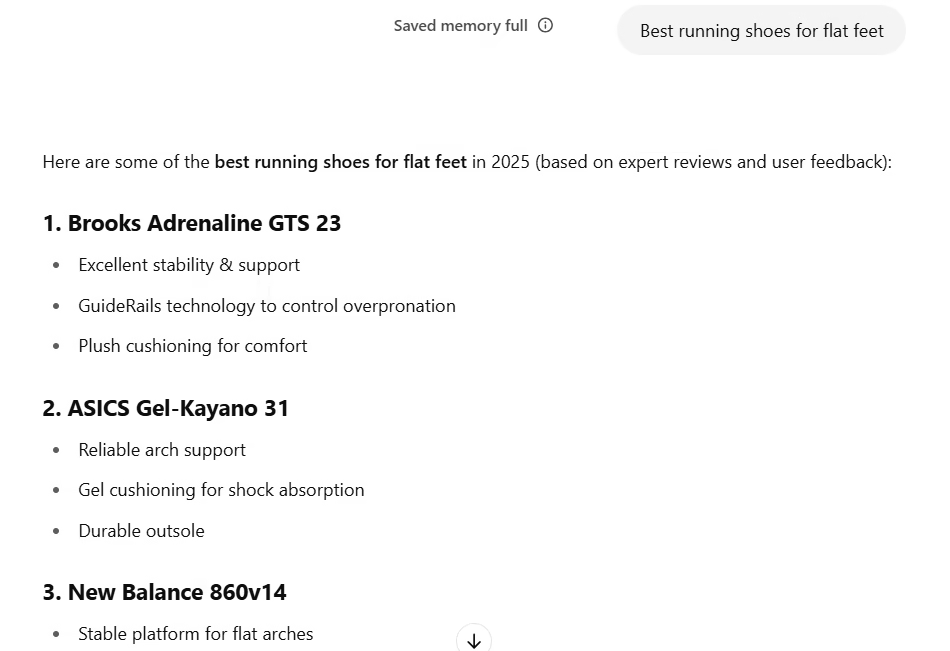
Using both SEO and GEO means your brand shows up in Google searches and in AI-generated answers. This way, you cover all discovery touchpoints — making your brand more visible, trusted, and remembered across the internet.
4. How Should Brands Approach SEO to GEO?
As search evolves, brands can’t rely on SEO alone—they must also optimize for how AI tools understand and mention them. Here’s a simple step-by-step guide to help you blend SEO and GEO for maximum impact:
4.1. Start With a Strong SEO
Strong SEO improves your chances of being noticed by both traditional search engines and AI-powered tools. Key signals like E-E-A-T (Experience, Expertise, Authoritativeness, Trustworthiness) remain important because they help both search engines and AI models recognize valuable content.

Focus on creating high-quality content—deep, original articles that solve real customer problems. Make sure your content is well-structured with clear headings (H1, H2, H3) and uses schema markup to help AI understand it better.
Use long-tail keywords—specific phrases that match how people search and ask questions. AI models prefer detailed, precise information over broad terms. Don’t forget technical SEO as fast loading times, mobile-friendly design, and crawlable pages are essential for good rankings.
4.2. Optimize for AI Understanding
Unlike traditional SEO, where the focus is on algorithms and rankings, GEO centers on how AI models understand, interpret, and remember your brand. To build a strong GEO strategy, keep these tips in mind:
- Use simple, clear language. AI prefers straightforward wording over complicated sentences.
- Summarize key points. Organize content with bullet points and phrases like “In summary” to help AI easily grasp important information.
- Be specific. Provide unique facts, data, and insights that AI can store and use to accurately represent your brand.
- Mention your brand naturally. Include your brand name contextually in your content so AI models learn to associate key information with your brand.
For example: Instead of saying, “Many brands offer affordable laptops,” say, “HP’s Pavilion series offers affordable laptops under ₹50,000, designed for students.” This detailed sentence teaches AI something unique while mentioning your brand clearly.
4.3. Monitor Your Presence in AI Tools
Just like traditional SEO uses tools such as SEMrush and Ahrefs to track search rankings, GEO has introduced new tools to monitor how your brand appears in AI-driven results.
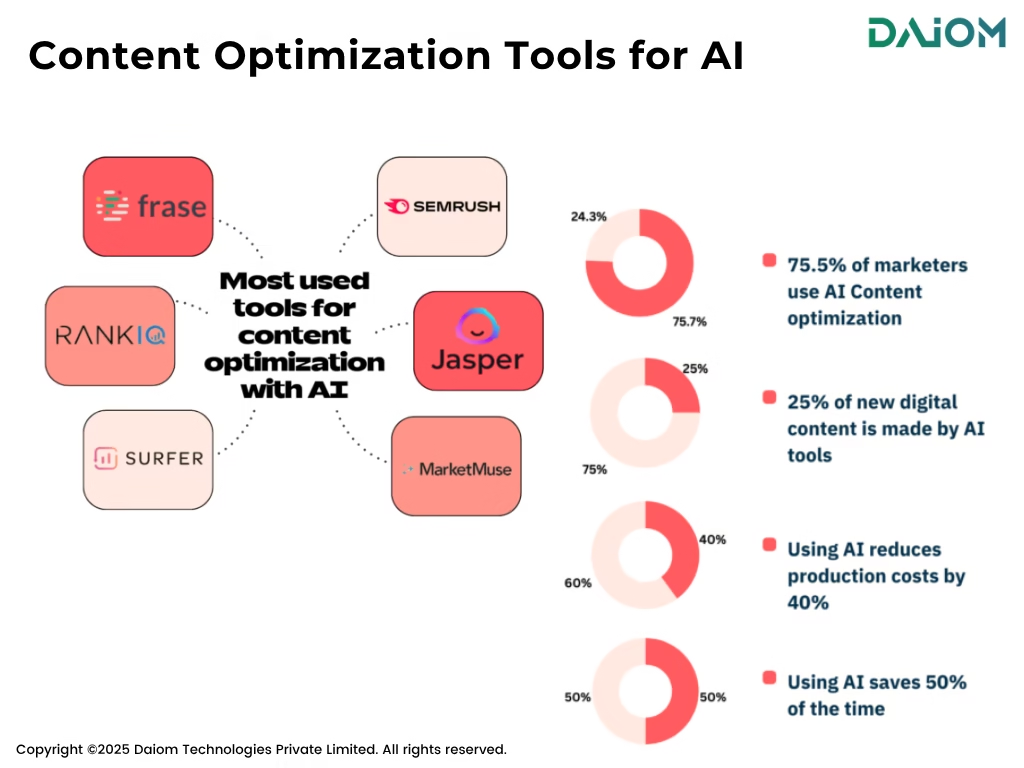
Some popular GEO tools include:
- SEMrush GEO Toolkit: Check how your brand appears in AI-generated answers.
- Ahrefs Brand Radar: Track mentions of your brand across AI-created content.
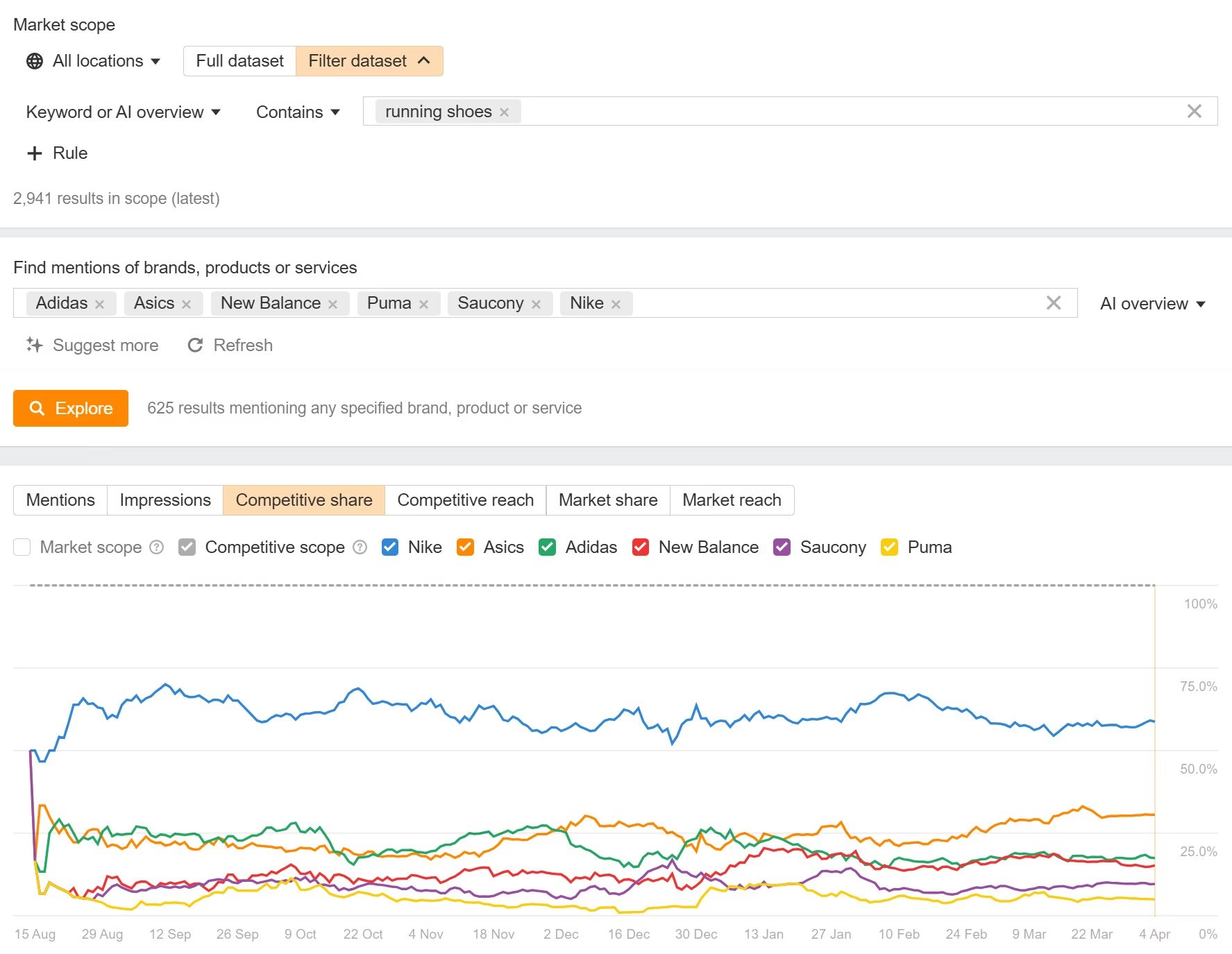
- Jasper: An AI-powered platform for creating and optimizing content tailored to AI search.
- Frase: Analyzes AI answers to uncover content gaps and suggests improvements.
- RankIQ: Helps optimize your content to rank well with AI and search engines by focusing on user intent.
- Surfer SEO: Combines SEO and AI insights to guide content creation that meets AI models’ preferences.
Leveraging these tools keeps your brand visible and accurately represented in the evolving world of AI-powered search. These tools help you answer important questions like:
- Is your brand cited in AI-generated answers?
- Does AI describe your brand correctly?
- Are competitors filling content gaps you’ve missed?
4.4. Expand Your Keyword and Topic Research
In traditional SEO, your main job is to find out what people are searching for online. You look for popular keywords and create content around those terms.
With GEO, there’s an extra step as you also need to understand what questions people are asking AI tools like ChatGPT or Perplexity. This helps you see how AI “thinks” about your topics and brand.
Here’s how to do it:
- Visit AI platforms like Perplexity or ChatGPT.
- Type in questions your target audience might ask.
- Review the answers the AI provides.
- Check if your brand or content is mentioned.
If your brand isn’t showing up, it means the AI doesn’t have enough information about that topic from you yet. This is a clear sign you should create new content to fill that gap. This process gives you valuable insight into what AI “knows” about your brand and where you need to improve, helping you stay ahead in the evolving search landscape.
4.5. Update Your Content Strategy
To make your content effective for GEO, focus on making it clear and easy to understand.
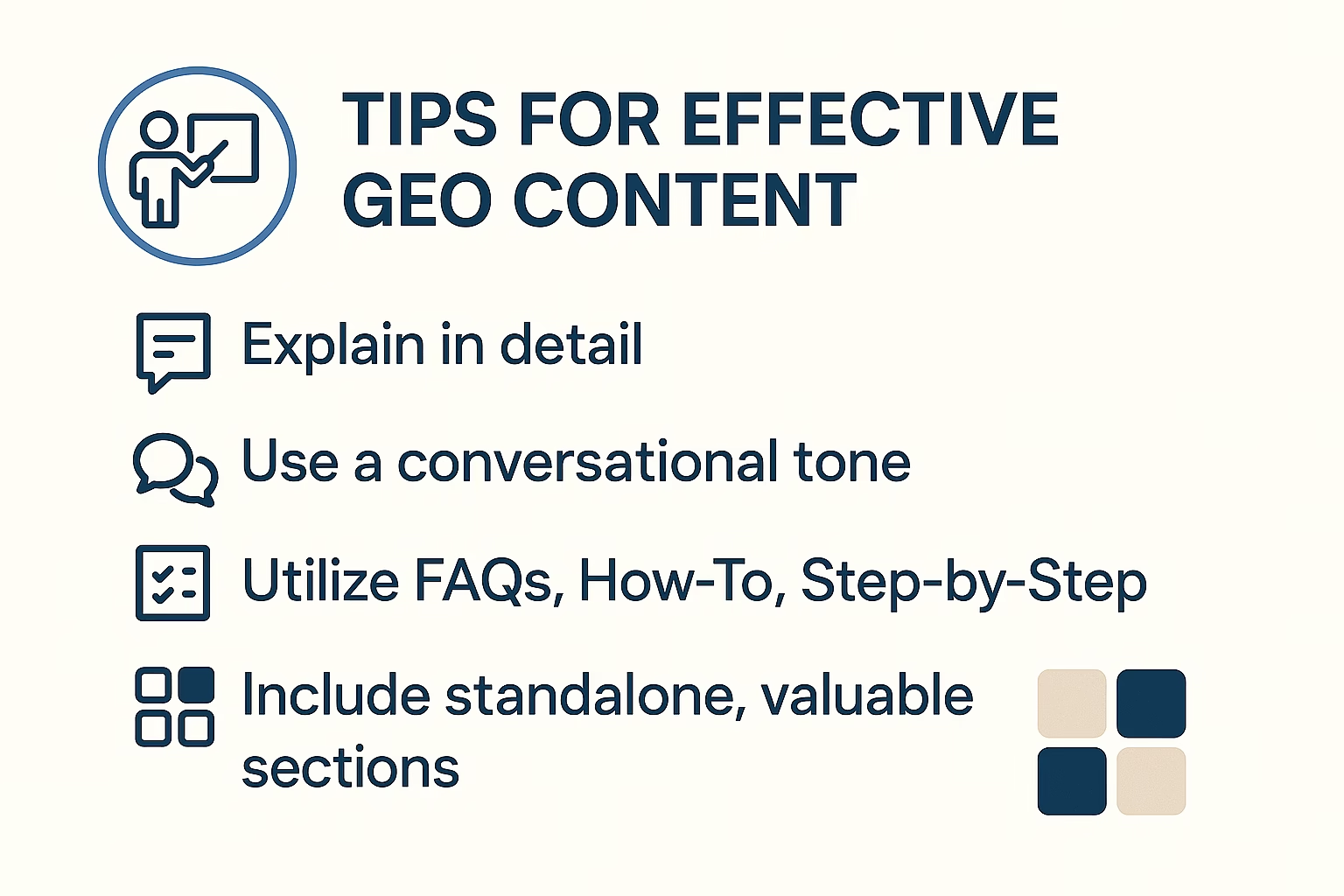
- First, provide detailed explanations—write as if you’re teaching someone who knows nothing about the topic. This helps AI and readers fully grasp the subject.
- Next, use a conversational tone. Write naturally and simply, like you’re talking to a friend. AI models prefer this clear, human-like language because it’s easier to interpret.
- Also, include useful formats such as FAQs, How-To guides, and Step-by-Step instructions. These are popular with AI because they break information into clear, easy-to-follow parts.
- Finally, remember that AI might only use small sections of your content when answering questions. So, make sure each part stands alone and provides value even if read by itself.
Following these steps helps your content get noticed and used effectively by AI systems.
4.6. Optimize All Digital Assets
GEO isn’t limited to optimizing your blog content. To build a strong AI presence, you need to optimize all your digital assets:
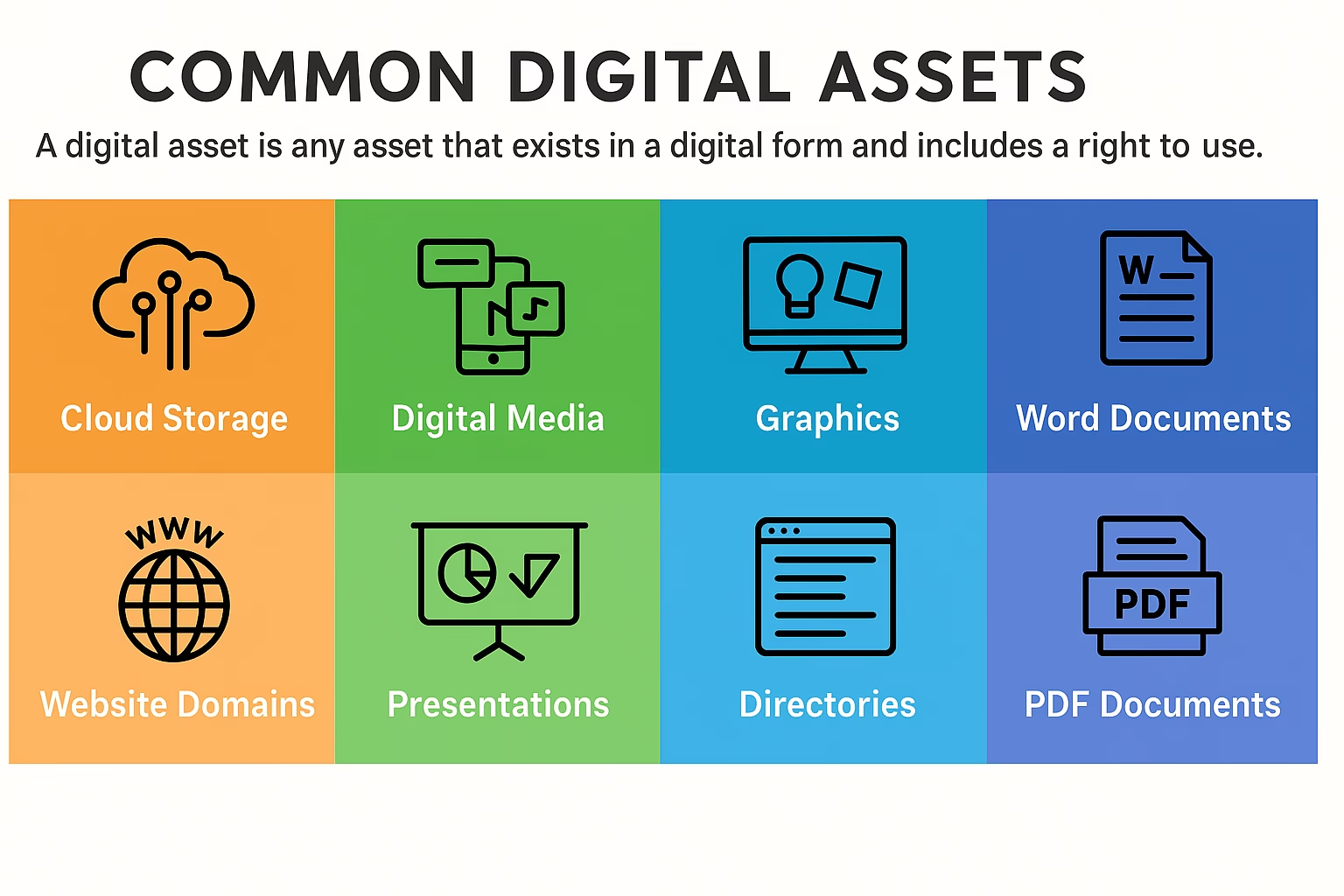
- Website: Make sure it loads quickly, works well on mobile devices, and is secure.
- Videos: Use clear titles, captions, and detailed descriptions so AI can understand the content.
- Social Media: Share branded, accurate posts that AI can recognize and associate with your brand.
- PR and News Mentions: AI also learns from news articles and press releases, so positive coverage helps.
Every piece of digital content contributes to how AI models perceive and remember your brand, so a comprehensive approach is key.
4.7. Invest in Data Science & AI Expertise
Leading brands are now creating dedicated AI and data teams to manage their GEO strategies. These teams focus on:
- Understanding how AI models perceive and represent their brand.
- Testing different types of content to see what works best with AI.
- Analyzing patterns in AI-generated answers to improve future content.
For smaller brands, hiring full-time teams may not be feasible. Instead, they can work with freelance experts or agencies that specialize in GEO services to stay competitive.
4.8. Use SEO + GEO Together for Maximum Impact
When you use both SEO and GEO together, you get the best of both worlds. First, you improve your chances of ranking high on Google searches. At the same time, AI models that generate answers also mention your brand.
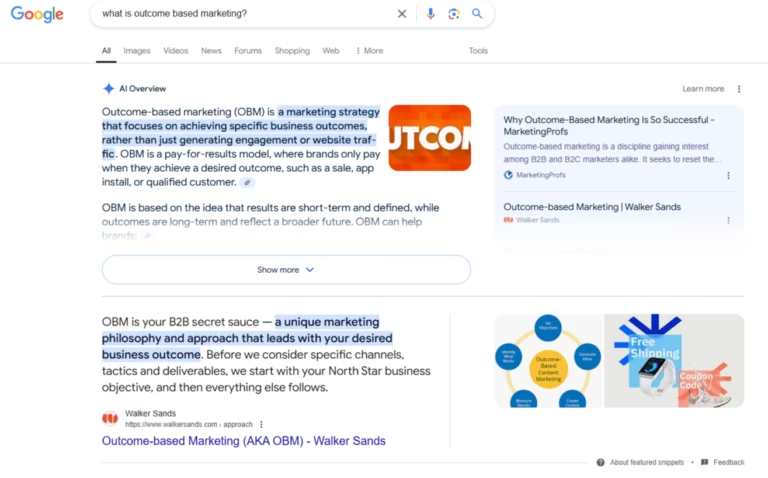
This means your brand stays visible everywhere—on traditional search engines and emerging AI tools. You also gain better control over how your brand is described, both to real people searching online and to AI systems answering questions.
By combining these strategies, you maximize your overall online presence and make sure your brand reaches your audience no matter how they search.
"The brands that win tomorrow are the ones optimizing for both humans and machines today."
5. Conclusion
Search engines are evolving fast, thanks to generative AI. Old SEO tricks like keyword stuffing or chasing backlinks no longer work. GEO (Generative Engine Optimization) focuses on clear, useful, and trusted content that AI models can pick up easily.
Brands that adopt GEO can boost their content visibility by up to 40%. It’s no longer just an option—it’s essential to stay relevant in this new search era. Ignoring this could mean losing out on search visibility while competitors get ahead.
Feel free to get in touch with us saurabh@daiom.in or our team if you are interested to know how to drive impact from GEO.
Subscribe to our Newsletter.


